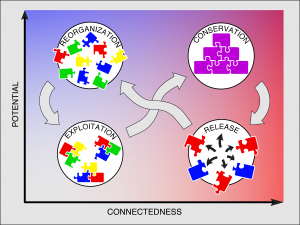Using the adaptive cycle to imagine sustainable transformation of teaching and learning systems
The word ecosystem is used a lot in education today to talk about new ways of organizing teaching and learning. Often the term is used to refer to more network-styled relationships (rather than hierarchy) among a diversity of players and roles (rather than a single bureaucratic system) using various modes of organizing learning experiences (rather than one-size fits all approaches).
The concept of the adaptive cycle is at the root of an ecosystem frame and worth exploring to understand more deeply the possibilities for transformation in education. The ecosystem lens on change in education helps us examine disruption and breakdown of the traditional education system as part of an adaptive process to a newer system that is better aligned to its context and conditions.
Source: Saveri Consulting, derived from Hollings, Radford, Weeks, Rodriguez, and Blakeslee.
Mature, tightly connected ecosystems can become rigid as they accumulate resources in their conservation phase. And while they may be efficient in their exchange of resources, they are inflexible and susceptible to breakdown when confronted by threats and disruptions, such as fires, invasive pests, drought, and pollution. These shocks drive a release of energy and nutrients as trees and plants burn, wildlife scatters, soil erodes (or floods), and resources become disconnected from their traditional relationships. Release leads to re-organization as gaps in the ecosystem invite new species and resources. Loss of low growing, dense plants may allow more circulation and sunshine to penetrate a forest and sets the stage for new plant species. New plants species may attract new kinds of wildlife—perhaps new insects and other creatures that create new relationships and resource connections. Re-organization of existing ecosystem inhabitants and new entrants enables a period of exploitation—a time of rapid experimentation by ecosystem inhabitants to learn what relationships are most productive and sustainable. Some new species fare better than others. Some may get crowded out by invasive species (weeds) while others may benefit from the stabilizing effects they have on the soil. As successful combinations form, they grow and accumulate more resources and reach and begin to define the transformation of the ecosystem over time. (see this for a detailed explanation of the adaptive cycle).
The ecosystem frame is particularly useful for orienting education system discussions around new opportunities, potential value, and relationships. The frame highlights the generative dynamic of relationships and novel responses to threats and disruptions. Rather than resist disruptions (such as new technologies and innovative organizational models) or fall back on existing (ineffective) responses, the ecosystem frame points out adaptive responses by examining opportunities created by the release of resources, re-organization of relationships, and exploitation (leverage) of new niches in the ecosystem.
Shocks to the traditional bureaucratic education system in the past few decades include disruptive technologies, increasingly diverse learning populations, new workforce requirements, soaring costs, and economic crisis (declining budgets).
Traditional responses from existing players seem to have only driven greater breakdown and release in the system, as student and new teacher dropout rates have increased, schools apply for charter waivers and reduce connection to the public system, and neighborhood schools close. This may not be a bad thing as breakdown and release have created openings for new ideas and players. Ed tech innovators have entered the teaching and learning ecosystem, as have community organizations such as libraries and museums. Venture capital firms, crowdsourced funding platforms, and employers are playing new roles as funders and partners. New individuals are finding their way into the teaching and learning field as professionals or para-professionals in new kinds of spaces of learning like media labs, techshops, maker centers, and learning hives. New school models are attracting new providers.
We’re currently in the early period of exploitation in which novel combinations of players are testing the ground and seeing what kind of sustainable value they can create. Content and curriculum development is proliferating among open educational resource spaces that support new combinations of teachers, experts, and learning agents like librarians. Foundations are seeding more cross-boundary partnerships and novel pilot projects. New ideas like blended learning and competency-based assessment are attracting experimentation and pilots. And schools themselves are beginning to open to more experimentation among its faculty and staff. The most damaging action to the education ecosystem now would be to stifle experimentation (the exploitation of opportunities presented by new ideas, technologies, and players) and the learning obtained from successful and failed initiatives.
The adaptive cycle is nature’s learning process that supports its resilience over time. For this reason, the ecosystem frame is a useful one for challenging the rhetoric around experimentation and failure (as in “don’t experiment with my children”) and creating a more productive conversation focused on learning and system improvement.

